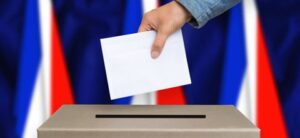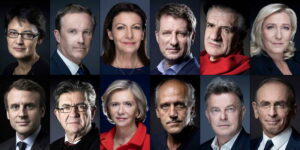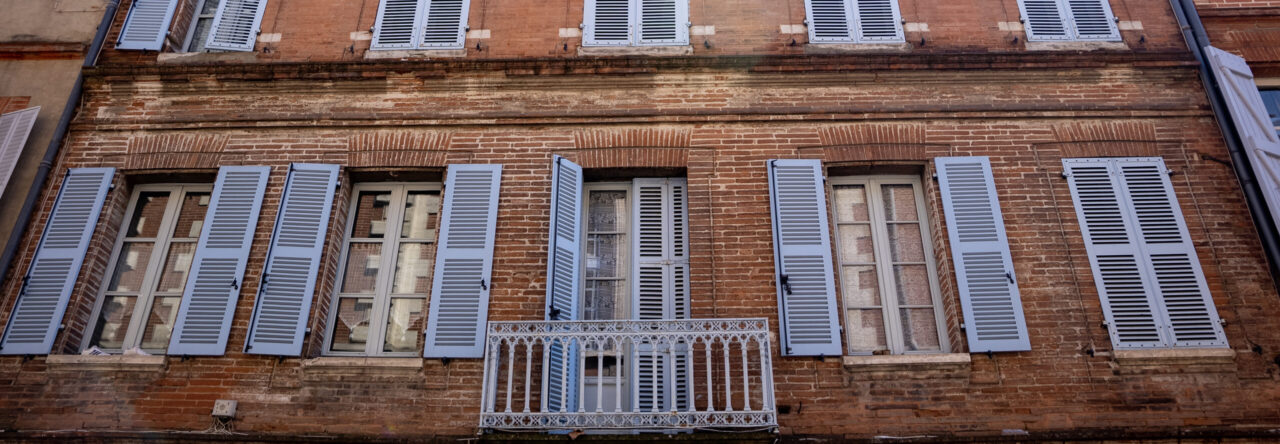
It’s a presidential election year in France and with the elections right around the corner, political activity is ramping up across the country. The elections start April 10, 2022 and the results will be announced April 24. Already one can see posters around the Jean-Jaures campus for candidates like Jean-Luc Mélenchon and Fabien Roussel. There are constantly students handing out flyers outside university buildings and the upcoming election has become a staple dinner-time conversation among many homestay hosts. The frenzied political climate in Toulouse is similar to many American cities on the eve of a presidential election, and with more extreme candidates on either end of the political spectrum, there seems to be a lot on the table. In the following sections, we explore the system of elections in France, the history of the election system, the profiles of the 12 candidates currently on the ballot, and protests. We also include perspectives from various homestay hosts and French university students as well as our own experiences living in Toulouse during an election year.
How does it works?
Every five years, the people of France elect their president in a two-round, multi-party electoral system. In this system, all French citizens over 18 years of age, both within the country and abroad, can cast a direct vote for the candidate of their choice. The presidential elections are composed of several main stages. First, the official list of candidates is published about seven weeks before the final round of voting. Each candidate on this list must have the nomination from at least 500 elected representatives, among other requirements. The next major stage of the election process occurs roughly four weeks before the final vote and is the official electoral campaign. Each presidential candidate has an upper limit on spending for their campaign, which is monitored by a committee. To ensure the most equal campaign process possible, each candidate must have strictly the same amount of airtime on television and radio. The first round of elections is the third major step in the presidential electoral process and happens two weeks before the second and final round of votes. The French people go to the polls and cast their direct votes during this time. Assuming no candidate wins over 50% of the vote, which would be an automatic win for that candidate, the second round of voting is scheduled and the two candidates with the highest percentage of votes proceed to the next round. This second vote is the final stage of the electoral process, where every citizen casts their vote again, this time between only the two candidates with the highest votes in the first round. Like before, this round of voting is a direct popular vote, where each ballot cast is counted directly towards that candidate and not as part of a more complex electoral college system, as is seen in the United States of America. The announcement of the results by the Constitutional Council happens within the next ten days, and the president is immediately elected following this announcement. Once a president has been elected, he or she may renew their presidency once more in the following election, but no more than that.
The voting History
Any French citizen who is 18 years of age on the day of the election can head to the polls on Election Day. In fact, even if you are not a French citizen, you can still vote in some local election. However, this has not always been the case. Only adult men were able to vote starting in 1848 while the law allowing women to vote didn’t pass until 1944. The first presidential election in France was won by Louis-Napoléon Bonaparte through popular vote in 1848. This was the first and only presidential election under the government rule of the Second Republic. The Third Republic then had 15 presidential elections under a completely different process. The two houses of parliament under the National Assembly would vote on who would be president. The third republic government had elections from 1870-1940 this is the longest to the day of the same process for voting. The Fourth Republic only had two elections and the winners of the presidential election were decided by the Congress of the French parliament. This was a combination of the National Assembly and the Council of the Republic. Starting in 1958 the French are in the Fifth Republic and have another new different process. There have been 11 elections to the day with one this year in 2022.
The candidates

There are 12 candidates who have made it onto the official ballot. Here’s a run-down of their profiles:
Nathalie Arthaud: Lutte Ouvrière. Arthaud is representing the far-left communist Worker’s Struggle Party. She is an economics teacher who teaches at a high school in Aubervilliers (a suburb north of Paris). The main tenets of her platform are defending workers against management and raising the minimum wage from €1,269 to €2,000 per month.
Nicolas Dupont-Aignan: Debout la France. Dupont-Aignan broke away from the traditional French conservative wing to represent an alternate conservative party. His party represents freedom of thought and freedom of the press as well as avoiding complacency. He aims to “restore dignity to the Republic”.
Anne Hidalgo: Parti Socialiste. Born near Cadiz, Spain but raised in Lyon, France Hidalgo represents a generic left-wing that aims to include a mix of various left-wing interests to gain a viable base.
Yannick Jadot: Europe Écologie- Les Verts. Jadot aims to unify leftist voters and advocate for France to put environmental interests higher in its political priorities and follow through on environmental pledges that Macron failed to bring to fruition.
Jean Lassalle: Résistons. Lassalle has positioned himself as a centrist candidate representing the rural population of France. He aims to “bring financial power back to the public forum”.
Marine Le Pen: Rassemblement National. Le Pen represents a far-right wing party in favor of economic nationalism, separating investment and retail banking, and energy diversification and is opposed to privatization of public services and social security. Her biggest competition is likely the even-more right wing candidate Éric Zemmour.
Emmanuel Macron: La République en Marche. Incumbent President Macron declared his candidacy for the 2022 race just hours before the March 4 deadline. Continuing to represent a centrist platform, Macron is hoping that amid the war in Ukraine voters will opt for continuity and certainty in re-electing him.
Jean-Luc Mélenchon: La France Insoumise. In his third bid for presidency, Mélenchon represents the far-left party of the Popular Union. He likely lost support after the French Communist Party decided to field its own candidate, Fabien Roussel.
Valérie Pécresse: Les Républicains. Pécresse represents a mainstream conservative agenda. She has been shifting slightly farther right to appease Republican hardliners and compete with other far-right candidates who are gaining momentum.
Philippe Poutou: Nouveau Parti Anticapitaliste. An autoworker without a high school diploma, Poutou is representing a far-left party. His ideas are similarly aligned with those of Nathalie Arthaud, another communist revolutionary.
Fabien Roussel: Parti Communiste Français. Roussel represents a similar voter base to that of Mélenchon’s France Insoumise Party. However, he has distinguished himself from other leftist candidates on issues of security and immigration as well as social justice. He also supports nuclear energy.
Éric Zemmour: Reconquête. Zemmour is an extreme right candidate supporting the “great replacement theory” that an elite conspiracy is trying to replace Caucasian people in France with African and Middle Eastern people. Thus, much of his platform is based on anti-Islam, anti-immigration sentiments.
https://graphics.france24.com/france-2022-presidential-elections-french-politics/
The demonstration and opinions
There may not be anything more French than protesting. The French people’s incessant protesting is fueled by the love of their country, la République, which they wish to morph into the vision of the people. This fight for a greater country is often traced back to the famous Bastille Day where commoners fought the feudal system, beheaded the king and placed France on the path to a more egalitarian society with their new constitution. Bringing their fight to the streets continued to be the way of change, as the communist party of the late 19th century and early 19th century brought support to the working class such as lowering the workweek from 48 hours to 40, significantly raising pay and creating the “congés payés”, two weeks of paid vacation. This method of protest set the standard for all seeking change. Today, the street is filled with people advocating for an assortment of ideas and movements. It wasn’t too long ago that the fights between “Les gilets jaunes” – the yellow vests – brought chaos near the capital over Emmanuel Macron’s green tax. They fought for people in rural areas who could not afford the new hike in gas prices but were not being kept afloat by social safety nets. While the yellow vest protests were more manic, demonstrations can be
easily tracked as they often occur on the same scheduled days, for example, a quick google search will provide a list of all planned demonstrations. These demonstrations can correspond to global, national or local issues, for example, protests in support of Ukraine have sprung up across the nation while the national vaccine passes and other covid guidelines have been protested. The advancement of France has long been attributed to the steadfast protestors and the changes are still being made to this day and will continue into the future.
The culture of protests in France and keeping track of all the candidates can be overwhelming, but we ultimately don’t have a say in this election since none of us can vote in France. So we decided to ask French citizens around us for their perspectives. One host sister (20 yrs old) said she has a lot of anxiety concerning the upcoming election and she is scared of the rise of the extreme right and especially the growing popularity of Éric Zemmour. When asked whether they thought the French system was better than the American system because there were more choices, a student’s host responded by saying they did not think it was better and in some ways, it was worse. In the US there is always a choice between a Democratic and Republican candidate but the host said that in France it usually comes down to 2 or 3 candidates and there’s a possibility that all three are conservative which she said was decidedly worse. Having so many parties on the ballot (many of them being similarly aligned) brings up the question of whether it’s better to vote for the candidate with whom you feel most strongly aligned or to vote strategically for the lesser of two evils if your first choice candidate doesn’t seem to have as good a chance. A Dickinson student recently witnessed a debate among friends at the university concerning this issue. One girl discussed how she would vote for Pécresse because she saw the election panning out as a battle between Zemmour, Le Pen, and Pécresse and said the other two would be worse so she would vote for Pécresse. The other girl was appalled that her friend wasn’t voting for Mélenchon since she had the impression that they had the same political views. The debate then ensued over whether it was better to vote strategically for someone you don’t agree with as much or to vote for your first-choice candidate. Clearly, friends can have different political views and similar to many American university students, it seems that students in Toulouse are not afraid to discuss their political opinions.

Leave a Reply